



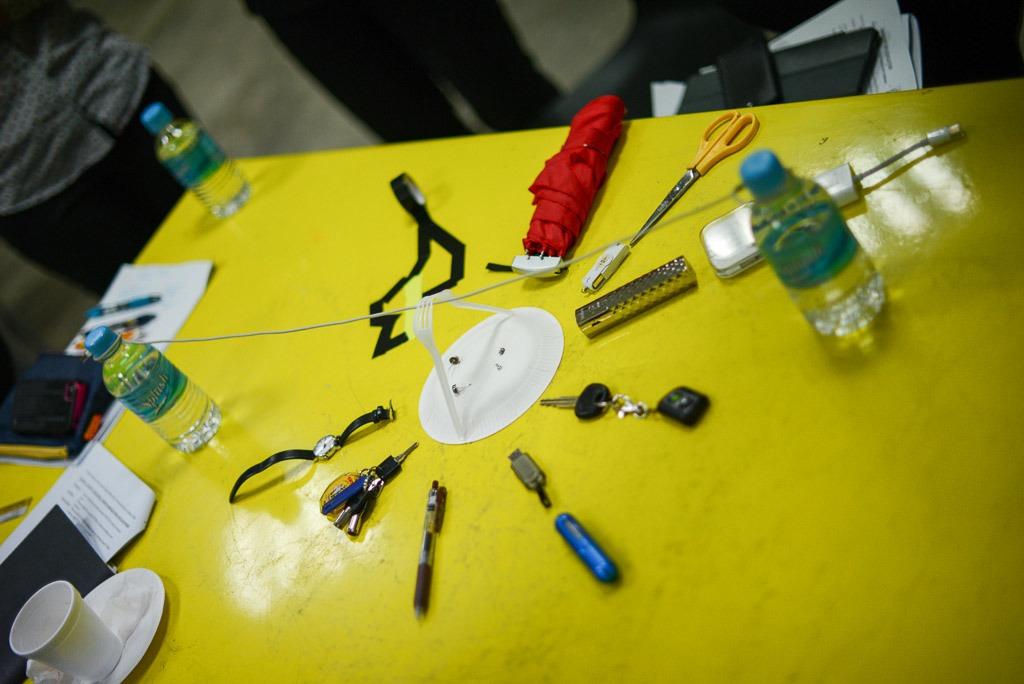






The Studio Thinking Framework (STF), developed by Project Zero at the Harvard Graduate School of Education, offers a set of lenses for thinking about teaching and learning in the visual arts. It features 1) eight habits of mind (thinking dispositions developed by the arts); 2) four studio structures for learning (the way arts instruction and learning experiences are organised). In this issue of STAR POST, the Cover Story articles will focus on Studio Thinking.
• Professor Lois Hetland, Principal Investigator of the Project Zero Studio Thinking Project, discusses the use of Studio Thinking framework for assessing student learning.
• Studio Habits of Minds (SHoM) are naturally inherent in the artistic thinking and practices that real artists engage in. Mr Lee Pheng Guan’s reflective essay sheds light on an artist’s practice, unveiling several of the habits of mind described in the framework.
• Mr Chia Wei Hou offers his thoughts on developing artistic dispositions through mindful play and thinking through materials.
• Mr Zaki Zulfakar shares a lesson idea which comprises elements of the studio structures: Demonstration-Lecture, Critique, Students-atWork, and Exhibition.
Assessment in the arts is complex, and through this article I hope both to “trouble” the notion and help educators address it with greater understanding. In arts education, in particular, assessment is a delicate process – because it is our intention to nurture the artist in all our students. If it is not dealt with carefully, judgment can very easily damage an artist, especially one who is budding. Educators need to think about the purpose of assessment – what is it for? If it is to separate good from bad work, we must ask, why? Ultimately, the only justification of assessment that is worthy of an educator is when assessment informs the artiststudent about possibilities for development and makes growth seem possible. When we offer critique to a student, it has to be in the sweet spot between too harsh and too soft, where the student can still hear the possibilities for growing but not stay stuck in current limitations.
Traditional methods in the arts work to accommodate assessment’s difficulties, and I advocate using them in schools. True, cultures of power and the market continue to corrupt these in professional practice, and too often the twisted and destructive methods that result leak into educational contexts and make assessment a show of oppression rather than a process for learning. But let’s set that problem aside to be solved in the professional field and assume that in educational contexts, assessment’s intention is to nurture growth. Traditional artistic methods for doing so include critique and review of various kinds (one-on-one “desk”-critiques or studio visits during classes; mid-process critiques; final reviews; process-folios and portfolios, whether actual or virtual; artist statements; and exhibitions).
Understand Art Worlds
Domain: Learning about art history and current practice
Communities: Learning to interact as an artist with other artists (i.e., in classrooms, in local arts organisations, and across the art field) and within the broader society
Stretch and Explore
Learning to reach beyond one’s capacities, to explore playfully without a preconceived plan, and to embrace the opportunity to learn from mistakes and accidents
Reflect
Question and Explain: Learning to think and talk with others about an aspect of one’s work or working process
Evaluate: Learning to judge one’s own work and working process, and the work of others in relation to standards of the field
Develop Craft
Technique: Learning to use tools (e.g., viewfinders, brushes), materials (e.g., charcoal, paint); learning artistic conventions (e.g., perspective, color mixing)
Studio Practice: Learning to care for tools, materials, and space
Engage and Persist
Learning to embrace problems of relevance within the art world and/or of personal importance, to develop focus and other mental states conducive to working and persevering at art tasks
Envision
Learning to picture mentally what cannot be directly observed and imagine possible next steps in making a piece
Express
Learning to create works that convey an idea, a feeling, or a personal meaning
Observe
Learning to attend to visual contexts more closely than ordinary “looking” requires, and thereby to see things that otherwise might not be seen

Text adapted from diagram found in Hetland, L., Winner, E., Veenema, S., & Sheridan, K. (2013). Studio thinking 2: The real benefits of visual arts education (Second ed.). New York: Teachers College Press, p.6.
But all these methods rely on the expertise of the reviewer. My colleagues and I conducted research from 2001-20071 that resulted in a book, now in its second edition as Studio Thinking 2: The Real Benefits of Visual Arts Education (Hetland, Winner, Veenema, and Sheridan, 2013). The resulting framework captures and describes four “studio structures” and eight categories or dispositions (skill, inclination, and alertness combined) of artistic expertise, the Studio Habits of Mind, so that educators can use them as lenses to insure that curriculum planning, moments of interaction in classrooms, and assessment all lean more purposefully into learning.
In viewing an object a student made, observers can see much about the craft used in its creation – but far from all. They can also interpret much about a student’s understanding and appreciation of how meaning is expressed through art – but we’re guessing, with more or less precision based on our expertise. And focusing on the final product to the exclusion of the sources of information revealed during the process hides much that educators need to know to make a valid assessment.
Assessment can readily fail the student and the educator. Setting aside for the moment the other seven Studio Habits of Mind and the other meaning of Develop Craft (Studio Practice, all of which is addressed later in this article), I worry even within the category “Develop Craft: Technique” that so much attention to skill in technique ignores and ultimately eclipses other important aspects of a developing artistic mind. For example, within judgments about craft, we frequently neglect an investigation of the student’s striving to attain high-quality craft (inclination). In my view, that is more important than the success or failure of the particular object being critiqued. Why? Because that object is only an indicator – it’s one moment in what we hope is a steady and evolving stream of work that the student will make. If our judgment about this object does not capture the student’s interest and fuel his or her passion for making work well, then we have done a disservice to the learning and the learner, and to our goal as educators who mean to educate.
I also worry that a focus on the skill visible in this object might keep us from addressing the student’s sophistication in recognizing when to use particular kinds of techniques, where to apply them, and how (alertness). If we identify a narrow band of quality in elements such as line or composition or toning, how can the student expand her understanding to bring nuance and novelty to expression? Students need to learn
to judge the mark, the form, the object itself in relation to its meaning and purpose –that is, to tie Craft to Expression. The mark is neither good nor bad – it is a visible representation of how the surface was touched with a tool. Is that manner of touching aligned with the meaning the work is meant to convey? Or is it in conflict? Does it distract or detract? Students need to be alert to the ways they use their skill to express ideas, the feeling of a work, and its conceptual intention.
All this implies strongly that assessment must rely on more than completed work, which is only one snapshot of a single event in a series about the artistic endeavor. Educators need to be driven and alert to their students’ choices and decisions throughout the process in order to rightly judge the ensuing product to be assessed –which is not the work, but, rather, the student herself. I am fond of saying that the students’ artwork is not the product that we, as educators, need to assess – although its quality is certainly the product students themselves must chase, just as artists do. Final works are a clue to what educators seek to assess – but only one. In that clue, we can see Craft, Expression, and possibly suggestions of a few other habits of mind – Understand Art Worlds, for example, if there are obvious visual connections to the work of other artists or designers. But the rest of the habits are revealed by observing the process and the documentation of that process, and then by comparing the developing work, behavior, and talk that occur during the process to each other, and then to other works made and processes engaged in previously by that student and, possibly but not necessarily, by other artists, both peers and professionals.
Studio Thinking offers eight lenses for viewing a student’s current state of artistic mind. What my colleague Ron Ritchhart has called “intellectual character” (Ritchhart, 2004) we may call “artistic character,” as revealed through the sophistication the student demonstrates in and across the Studio Habits. We see that sophistication in three ways – what students make, say, and do. Some of the Studio Habits of Mind are visible in finished work (what students make). Some are only visible in the collected documentation of the work’s development over time (a deeper exploration of what students make). Some are only visible in the student’s behavior as she makes the work – what she does. And some are only available in what students say during the making and about the end result. In other words, the workings of the students’ mind are only available to us when thinking is made visible throughout the process of creation – and that makes careful observation and documentation of process a necessity for valid and reliable assessment.
Assessing Artistic Character
With amassed information available – through documentation collected in processfolios (actual or virtual, including works, texts, and images/video of planning, drafts, and reflections), and through memory unpacked in reflection and conversation during desk-critiques, mid-process critiques, final reviews, and exhibitions – educators and students have the material necessary to conduct assessment. The next part of this article describes, through the lenses of the remaining Studio Habits of Mind, what educators need to look for in those documented records of process.
Engage & Persist: Clearly, we can’t see much of this disposition in final work itself. Howard Hodgkin’s works, for example, look like he splashed bright paint on a canvas and frame in a few minutes (http://phillipmemories.blogspot.co.uk/2012/06/howardhodgkins_13.html). On closer inspection, more subtlety can be discerned that must have resulted from effort over time. But I think few could uncover the months and sometimes years of attention the artist gave to these fresh and seemingly spontaneous works. Similarly, we cannot see what engaged an art student nor how he or she persisted unless we were there or have documentation that reveals the process. We can guess, but to know, we need more information than a single work can supply.
Envision: Similarly, without documentation, we have very little access to the ways students think about the work during its conception and realization. With conceptual sketches, mock-ups, thumbnails, story-boards (or images of these), short reflective texts, documented conversations and mid-process critiques (often through video and/ or audio files), information is available to see how an idea developed, how it was explored with materials, and how it came to interact with and be expressed through materials. Without these data, we are left without a way to check how students are imagining their work into being.
Observe: Artists give looking time, investigate sources visually, and look from a variety of perspectives and distances, all the while asking questions, seeking connections, and imagining possibilities. Only a fraction of that process can be seen in the final work. As with envisioning, it’s only possible to understand an artist’s use of looking (and other forms of perceptual investigation like listening, touching, tasting, smelling) if the process of creation is documented and/or if we are present to observe throughout its development.
Reflect: The questioning and explanations in which artists engage may be visible in a final review if the artist is present to tell us, or in an artist statement, but they are rarely visible in the work itself. Although Modernism set the expectation that “works should speak for themselves,” contemporary artists have moved far from that position. A recent show at the Brooklyn Museum, “Ai Weiwei: According to What?” (April 18 –August 10, 2014, http://www.brooklynmuseum.org/exhibitions/ai_weiwei/) had process videos and texts in each room that depicted and explained the context of the work to make its layers of meaning clearer. The ways artists judge quality, of a particular work and of works in general, is, of course, somewhat apparent in the final work, since we must assume that the finished piece represents the artists’ best effort to realize his/her idea. But much more information on these qualities is available in documentation of mid-process critiques, written reflections, and sketches made during the process. These can reveal how the artist identified and attempted to resolve issues, allowing us to see what the artist notices as something worth resolving (alertness) as well as his/ her capacity (skill) and motivation (inclination) to do so.
Stretch and Explore: Unless documentation of the process of the work’s creation can be reviewed, or unless the reviewer was present to observe during the process, the final work reveals merely a hint at how the artist pushed him/herself, played with ideas, and used errors as opportunities for new ideas and analysis that led toward more effective efforts at resolution. How much the artist valued exploration, was sensitive to moments in the process where inserting play might move the work ahead, or what skills the artist employed in its service is veiled unless it is made visible through documentation or observation.
Understand Art Worlds: While we may be able to see something in the final work that references a conversation that other artists have begun, there is much that is invisible without documentation. Many of the artists who influence an artist’s thinking about a work may not be visible in the finished piece, since it could have been their ideas, their approaches, or their techniques that guided the artist’s efforts. Similarly, unless the artist wrote or talked about these influences, there is no way to know what about these artists drew his/her attention, nor what he/she missed that might have informed the process. And the “Communities” part of Understand Art Worlds, where artists work with other artists in a host of ways (e.g., parallel play, critical friends, mentor influences,
collaborative teams) can only be observed by the process being made visible through observation, documentation, or both.
By identifying the depth of what valid assessment should address, I do not mean to imply that teachers must gather and document data on every student or analyze every quality characteristic on every day. That is impossible, given the constraints of teaching large groups. But by becoming familiar with what counts as worth assessing, teachers can set up systems to gather and process more information over time.
Many teachers build process-folios by tossing dated works, images, and reflections into pizza boxes that line shelves or floors like books, identified with students’ names on the spine. By including a grid of the Studio Habits, one teacher was able to review 5-10 such portfolios every school-night before she left for the day and make brief notes on her observations (e.g., in the “observe” cell, “October 31, drew detailed skeleton hand after comparing his hand to skeleton’s”). Over time, the information accrued and began to tell a story of what the student was working on and ignoring, which the teacher could then address in instruction as she saw fit and/or synthesize at reporting times. Electronic process-folios can be used similarly and take up less space.
But the key to managing large numbers, in my view, is to give a lot of the responsibility for assessment to the students themselves. Leave cameras around so students can take photos of their works-in-process and post them to their own documentation site or blog. Train them to write explanations of what they post, describing what they’re thinking, exploring, and learning. This has the advantage of allowing the teacher to see students’ commitment (inclination), what they are noticing (alertness), as well as what they can do (skill). She can then read a few blogs/process-folios on an ongoing basis, interpreting the information available in cycles and iterations. Even if a teacher only gets to every student once a month, she’ll have mountains of data at reporting periods, with two or three summaries to synthesize.
“Hui Min made subtle drawings, and now she needs to focus on Engage & Persist in documentation so that she and I can understand more about her process in producing them.”
Add to that the chance, when projects are completed, for students to present their process to reviewers, using the documentation along with their finished works, and we have a rich and valid assessment of what we really mean to assess – the students’ developing artistic character.
Once such clarity of assessment is in place, the assigning of grades is less onerous. Grades, though, is an entirely different article, which would address quantifying the ongoing judgments made by students and teachers into levels and how rubrics do and do not make sense in that effort. But it is my view that getting the learning part of assessment straight first is most important. With that in place, I trust teachers to assign grades fairly and with compassion for their budding artist students.
1 With thanks to our funders, the J. Paul Getty Trust, the Ahmanson Foundation, and the US Department of Education, as well as our collaborators, the Boston Arts Academy, Walnut Hill School, and the educators of Alameda County, California, and the many educators whose work with the framework has informed our thinking.
“Soo focused on observe this term, and he needs to begin to focus on the connections to stretch and explore and envision to develop his work more deeply.”
MR CHIA WEI HOU SENIOR TEACHER, RAFFLES INSTITUTION
It takes a mind-set shift to consider the main objective of teaching art as not merely to make students produce beautiful and excellent artwork, but to create artists out of students – students who will demonstrate and exhibit artistic behaviours.
Allow me to explain what I mean: artistic behaviours are what we do when we make art, or make something artfully. The real concern and interest shift from objects and their qualities to the behaviours, processes and purposes fulfilled by that engagement with the objects.
The question to ask then is “How do we cultivate artistic behaviours in our learners?”
One of the ways is to slow down and spend more time on the processes of enactment, making and investigation, as well as exploration of the materials.
Children are innately curious about materials. They are willing to play with them to see what they can do when interacting with them. This act of serious play is fundamental in all art making processes. The plausible reason children lose that natural inclination is that they become accustomed to regulating their behaviours, out of fear of making mistakes and being reprimanded for them.
Curiosity and imagination in the handling of media and materials are important artful behaviours of artists. Orchestrating investigations of materials is an important part of making art – developing an understanding of how visual forms, combined

with materials, create meanings is critical to the art making process. There is a profound pleasure that can come from working with art materials, processes, and forms; that pleasure is a central motivational force for both artists and learners.
Learning art is to learn artistic conventions, the symbolic language found within the artistic practice, and the modes of thoughts and perception. Learning art is learning how to take the material, “play” with them, and transform them into something extraordinary.
Human beings, by nature, like to make things special, often by manipulating, shaping and forming materials; at the same time, invest emotions and expressions within the materials. Working with materials results in the creation of forms. Creation of forms results in the representation, and thus art.
It becomes very clear to me that teaching art is simply about enabling students to think and behave like artists – to make good decisions based on sound aesthetic reasoning, to act and develop their craft and practice, and to acquire an extensive repertoire of skills and ideas about materials and artistic expressions.
Hence, an art teacher's job is to create an environment, culture and curriculum to allow for this journey of discovery of materials, ideas and expressions, and to build students' lived experiences and repertoire of artistic behaviours so that students can fulfill their creative potential and participate in the world artfully.

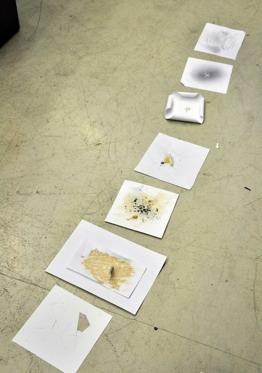
PROGRAMME
My decision to do a Masters in Fine Art came about after going through a significant event in my life – the passing of my father. I have always felt the need to research on something important in my art practice, but nothing was more critical than to address the issues surrounding mortality at that time. I went into this with a sense of urgency, to try to understand as much as I could before my memory fades. Memories and traces thus became the backbone of the bulk of work I produced during my course.
A yearning to hang onto things comes naturally if one has experienced the loss of something precious. I have always understood that our lives are not eternal; therefore I think it is futile to prevent death per se. To me, the most frightening aspect of losing someone close to you is that you can no longer have new experiences together: you are stuck with what you have – old memories have no possibility of being renewed or replaced with new ones. Since his passing, the number of stories that I can tell about my father has started to stagnate, or worse, diminish. I too, am getting old and with that comes the deterioration of my memories. How does one prevent the loss of precious memories? This, to me, feels like swimming against the current. To aid retention one needs to discard certain details which inevitably changes real events to somewhat fictitious ones. This is not necessarily a bad thing. Many important stories from the past are passed down in this manner, sugar coated or edited heavily. In my research into defining memories and forming traces of previous existences, I started making objects based on past experiences. My preoccupation with mortality meant that some of my creations fall into a category similar to memento mori. Yet, the language I have forged does not require the use of skulls or other common memento mori symbols. I am interested in suggesting the temporality of life and I rely on my
choice of materials to do so in my work. It is also precisely this reason why my work frequently includes a durational element. The materials and objects I used are also commonplace and readily acquired to insinuate the ‘everyday-ness’ of mortality.
Paraffin wax is one such material. A by-product of petroleum, it has a low melting temperature, which makes it rather unstable, an impermanent quality that sits well with my pursuit of the ephemeral. Melted paraffin creates a thin brittle layer when poured onto objects, and subsequent coats will build up the form, eventually the object loses its original ‘shape’ and we can no longer see details. I have employed this method of ‘coating’ for some of my works, one of which is titled Still Life (2013) (figure 1).
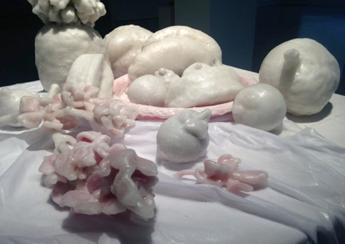
On a small square table I arranged some tropical fruits (durians, starfruits, mangosteens, pineapple and bananas) and flowers (orchids) in a typical still-life setup found in paintings, except that these objects have been heavily pre-coated with wax. The choice of creating a still life setup is a direct response to vanitas paintings in the past that portray the transient nature of life. Such paintings frequently include subtly rotting fruits and withering flowers to show that nothing lasts forever. My gesture in coating these objects with wax has a double meaning: a desire to preserve but at the same time, to obscure. Preservation of food or animal specimens using wax has been a method used for centuries. When done properly, the preserved item will be sealed off from the environment to delay oxidisation and subsequent decay. To reinforce the preservation, I have chosen to coat my objects with more layers, resulting in the loss of visual details.
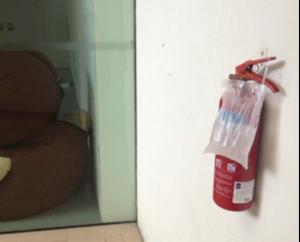

I have also started using paraffin wax to create casts. Once coated onto certain materials, the wax solidifies to hold the shape of the material. Examples of such works include Forgotten Things (Plastic Drink Bags) (2013) (figure 2), and Weight/less (2013) (figure 3). Forgotten Things (Plastic Drink Bags) consists of 30 plastic drink bags cast in wax to create the illusion that they contained certain beverage. These are then hung randomly around LASALLE’s McNally campus. Weight/less, the cast of a plastic bag seemingly holding some contents, started out as an attempt to create a more permanent version of an otherwise temporal existence. We use plastic bags almost on a daily basis – to hold objects with a status higher than that of the bag. The bag in this case serves as a protection, a skin to ‘contain’. The bulge of the bag in both works suggests the existence of the content, but it is actually empty as the object is removed after the package is casted. What the viewer sees is presence of absence, a reminder that the bag used to hold something more significant than itself. Even though the content is not present, we may still continue to cling onto the idea of its significance through a
trace. Through examining my own situation, I realise that I have the habit of clinging onto things that are no longer useful, spoilt or are no longer there. I am possessive. Perhaps this series of works are reminders for me to let go.

As an artist, I like playing around with materials. For my studio practice, I started experimenting with melted paraffin wax mixed with sand. I wanted to make a tiny ball with the mixture. The idea came about when I decided to create an object devoid of any common, symbolic meaning or association, while at the same time consisting of the two main ingredients. The sphere was the most immediate form that came to my mind. It is a very natural shape and to me is very suitable for my purpose – no kinks, no imperfections, no complications.
The choice of using sand in my work has multiple meanings. Sand is classified under one of the five Chinese elements ‘土’ (Earth) which represents stability and resistance to change. Created from the erosion of rocks and landforms, sand, to me, is time/ timelessness. I had wanted to work with an elemental material that exists in abundance, although one could argue that sand is no longer readily available in our land-scarce Singapore. Actually, sand IS the main ingredient for our buildings apart from cement. However it is rarely seen in its original state except in construction sites (and beaches, of course). The fact that you will hardly see traces of it highlights the love-hate relation people have with sand. To most, the burden of having to get rid of it for cleanliness and health reasons is a pertinent one, but there is no denying its importance: the houses we live in that we painstakingly keep clean and hospitable is built with sand.
Paraffin wax, in this case would serve a practical function: to bind the sand together. At room temperature, paraffin wax is also brittle, therefore creating a weak bond for the
sand. This is noticed as the ball is being moved around, leaving traces of loose sand. The mixture is thus a forced union of contrasting characteristics.
While working on this, I also chanced upon information on a Japanese pastime called dorodango, where children and adults would create shiny balls out of mud. The idea of making a dorodango fringes on play and its meditative/therapeutic nature requires a considerable amount of time and patience. After devoting so much effort into creating this ball and obsessively making it shiny, it is noticed that the maker becomes very attached to his precious creation.
I realise, before any knowledge of this popular Japanese pastime, that I too became attached to making my sand/wax sphere. My obsession is manifested as ‘growing’ the sphere and making it as perfectly rounded as possible. I began my daily ritual by painstakingly preparing the sand and wax mixture and coating the ball as evenly as possible. What started out as experimentation is growing into an obsession. Once I step into my studio I am immediately drawn into adding a new layer, as if I am creating something with great importance, and by conscientiously growing it, I will reach a point of finding some kind of ‘truth’. Till date, I have added months’ worth of layers onto my ball and it has grown into a sphere weighing a few hundred kilograms.
Upon reflecting on my daily ritual/routine, I have since discovered that this relentless habit of building and perfecting IS the ‘truth’ I am seeking, that I, like many people, have this innate drive to want to perfect things. This attribute, while encompassing the possibility of creating something potentially ‘beautiful’, is in opposition to my idea of art making – exercising outright control.
My process is, to some, therapeutic, but I have observed that therapy is preceded by the urge to make the sphere bigger and bigger. Preparation of the materials is getting tedious as the sphere grows, and the amount of time spent on covering a new layer has increased significantly. The drastic increase in mass and volume is posing a huge challenge in manoeuvring the sphere. The constant squatting also took a toll on my knees and back. It is getting progressively more difficult as I build this object, a mere spherical form. I have literally created for myself a heavy burden! But I am not prepared to stop. This is an on-going work and I will continue adding to it as long as I have time, space, materials and strength to work on it, although I dread the day when I
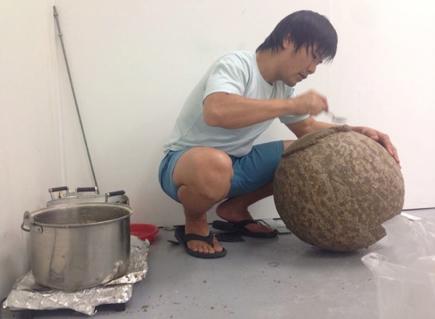
no longer have these. I am fearful that the day will come when I no longer have the capacity to work on it and I have to walk away from it. Or perhaps it might collapse on its own weight since the wax that holds the form is rather weak. I have formed a situation where I know I will have to eventually face the end. The uncertainty of how and when it will end is a daunting one, but I have set myself up for this ‘failure’. My fear will ultimately be realised: I have to let go of my burden.
STAR POST (Art) cover image: Lee Pheng Guan, Sisyphus (2014). Performance with sand and paraffin wax, dimensions variable.
TITLE OF LESSON : InstaART
LESSON OBJECTIVES
By the end of the lessons, students will be able to:
•Make original interpreta>on of themes/task from different perspec>ves.
•Demonstrate an understanding of POD and EOA and apply to photography.
•Integrate a range of art elements and design principles effec>vely according to ar>s>c intent.
•Develop original ideas through a coherent interpreta>on and analysis of informa>on gathered.
•Select and experiment with various photography phone apps.
•Engage in a current and fun photography lesson.
STUDENT'S
PREREQUISITE KNOWLEDGE
•Elements of Art
•Principles of Design
•Knowledge of Basic Phone Apps (e.g.: camera360, Pcamera, Panorama)
MATERIALS Provided by Teacher
•Powerpoint slides on photography
•Worksheets & References
•Samples of fine art photography done by teacher
•Other Reference:
•hTp://www.thesartorialist.com/ for fashion photography (street fashion)
•hTp://digital-photographyschool.com/100-things-ive-learnedabout-photography
•Sample works by Henri Car>erBresson
EQUIPMENT Computer, Visualizer, Whiteboard
RESOURCES Powerpoint® Slides/Prezi Presenta>on

Provided by Students
•Any camera
•Mobile phones





SEATING ARRANGEMENT
1.STUDENT SEATING
2.PLACEMENT OF RESOURCES
3.PLACEMENT OF EQUIPMENT
Materials are easily accessible to minimize movement in the class
4.PRESENTATION AREA
Students will be able to interact more efficiently in this arrangement, closer to the projector
IntroducDon (10 mins)
•Teacher distributes hand-outs. (Art Representa>ve to assist teacher).
•Teacher discusses perspec>ve, space and balance with students. Teacher asks students to recall the basic POD and EOA. Teacher informs students that this basic knowledge is also essen>al for photography.
PresentaDon/Discussion (50 mins)
•Teacher shows sample works by Henri Car>er-Bresson (father of modern photojournalism). Students iden>fy basic EOA and POD such as balance, posi>ve/nega>ve space, composi>on etc.
•Teacher uses the 5Ws and 1H technique for Q&A.
•Teacher shows his photography works to students. Works are categorised under buildings/architectures, landscapes, people, black & white photography etc. This is to give students a beTer perspec>ve and idea of what to capture. (refer to: hTp:// www.star.moe.edu.sg/cos/o.x?c=/star/ pagetree&func=view&rid=1146221)
•Teacher talks about Instagram photography.
•Teacher shows students samples of his works taken using mobile phones. These include documenta>on of travels, photographs of food, as well as selfies.
•Refer to hTp://www.thesartorialist.com/ for fashion photography (street fashion) (Note: Tell students that they can also draw inspira>ons from song lyrics, quota>ons etc.)
•Art ac>vi>es at Siling Sec can be viewed at hTps:// www.facebook.com/slss.art
DemonstraDon (10 mins)
•Teacher shows students how to take a photograph using mobile phone, as well as the types of apps than can be used/applied.
•Students listen aTen>vely to teacher during presenta>on and take notes when necessary.
•Laptop and projector
•Assignment checklist
•Demonstra>on samples
•Students will be given the opportunity to ask ques>ons (Q & A).
•Students try out some of the photography phone apps.
•Laptop and projector
•Assignment checklist
•Demonstra>on samples
•To create a disciplined art-making environment.
•Students will have a beTer understanding of what are expected of them for the day’s lesson.
•Students give comments and feedback.
•Students clarify doubts they have with the teacher.
•Laptop and projector
•Assignment checklist
•Demonstra>on samples
•Students will have a clear understanding of the concepts taught.
•Teacher will explain to the students the different outcomes and ar>s>c possibili>es that can be achieved with phone photography.
•Teacher will inform students that they can use this mode of documenta>on to get authen>c, primary resources for their N or O levels Coursework.
•Students will gain some understanding of fashion photography, as well as a more polished and sophis>cated selfie.
•Students will be able to visualise how these apps can be applied.
•Students will learn to communicate and express their thoughts, experiences and feelings through class discussions.
Studio Work (50 mins)
•Teacher asks students to take photographs around the school.
•2 Perspec>ve/Depth photos
•2 Space/Balance photos
•3 Ar>s>c photos
•3 Selfies (Photos should not show the faces)
Follow-up AcDvity
•Students choose their favourite photographs.
•Students learn simple photo edi>ng skills (Photoshop).
•Students talk and reflect about their photographs.
•Planned outdoor photography lesson.
•Planned mini exhibi>on to showcase artworks and celebrate success.
•The emphasis of the lesson is not on technical approaches to photography but more towards geing students to photograph with their feelings and to observe with their eyes than the lens.
•To read from hTp://digital-photography-school.com/100-thingsive-learned-about-photography
•Pick out relevant points to share with students (especially the myth about good camera equals good photograph). The purpose of this lesson is to show students that they can get good photographs by using mobile phones as well.
•Teachers are advised to try out the lessons before teaching. Though it is useful to refer to ar>st reference and resources via YouTube and various websites, these are merely secondary sources. The best resource is the teacher’s own. Lessons will be more authen>c and fruikul when they come from the heart.
•Students take photographs around the school compound.
•Students collect their bags from the side of the art room and await dismissal from the teacher.
•Students will be able to apply what is shown and taught in class.
•Students will be able to work independently.
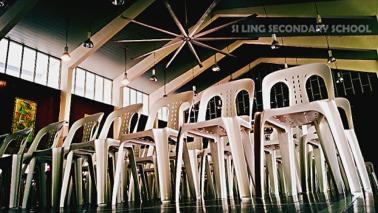

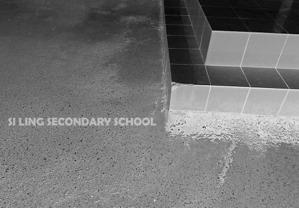




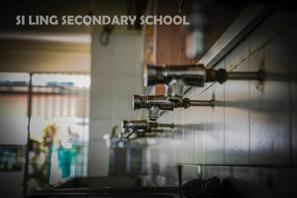

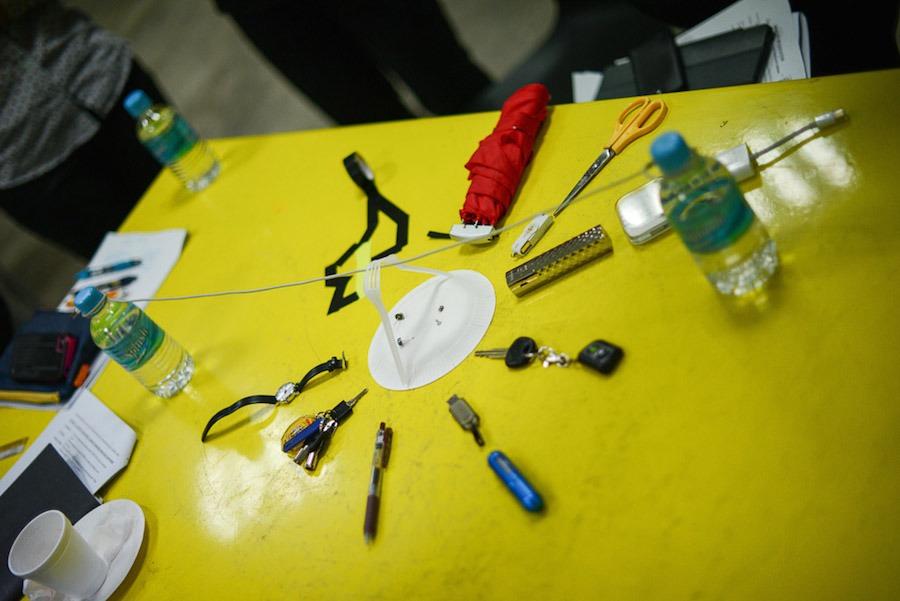
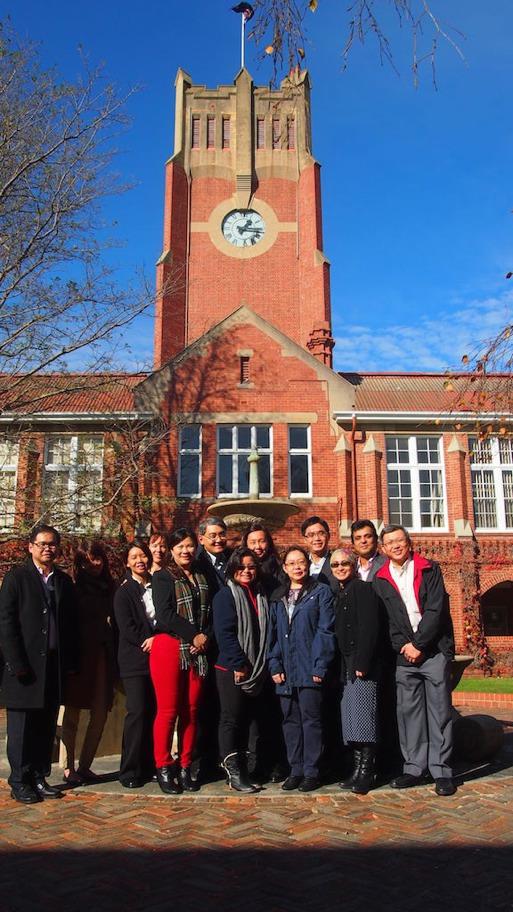
With the intent of developing an understanding of industry practices, the role of the arts in the community, as well as arts advocacy efforts, five Senior Teachers (STs) ventured out of their art studios to explore Nanyang Polytechnic’s School of Interactive & Digital Media (SIDM).
During the five-day Industry Attachment programme in June, the Senior Teachers gained some insights into the Design and Motion Graphics Animation arena through lesson observations and dialogue sessions with the SIDM faculty. Below are snippets of their observation and reflection:
For students: It shows them what it means to be work-ready, what clients would be asking and demanding of them; from dress code, to the way they carry themselves, their presentation and preparedness in the project. Anything that is overlooked is brought to the open through thought-provoking questions; answers are not given, but explored and discovered.
For staff: They learn about each other’s professional viewpoints. In a way, it serves as a form of standardization on how to evaluate the students’ works. The teachers have to be prepared to be challenged not just by the students, but by their colleagues as well. This requires trusting each other. Trust in each other that they are not saying things to make themselves look better than the others, but that they are saying it to clarify or to offer a different viewpoint. Thus, the teachers grow and learn from the differing opinions as well.
Mrs Jane Grosse, Rosyth School
During the critiques, I observed that the lecturer reversed his role by asking his students to ask him questions (e.g. what do you want to learn from us lecturers?), instead of him asking them questions. This is something that I would like to experiment during my art lessons. I will use the ‘role reversal’ by allowing my students to ask me questions with regards to their artworks, instead of me asking them most of the time. It is also interesting to know the kind of questions that I would be receiving, and how I can use these questions to further develop my art lessons or critique sessions.
Mr William Tock, Siglap Secondary School
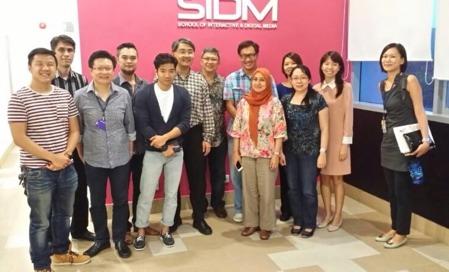
Celebration of imperfection, potential and process. E.g. The teachers demonstrated this in their critique and supervision on very open-ended assignment tasks whereby a range of interpretation and achievements are produced. Failures are allowed and embraced as part of the process of learning.
Mr Tang Li Jen, Victoria Junior College
‘throwing the students into the deep sea’ where the destination is unknown. The idea of making everyone, students and educators, feel like ‘they are in the same boat in the open sea’ is deliberate and it deconstructs the power structure. Thus the practice of celebrating the imperfections and the potentials, and not just the final successful outcomes, is to the team a humbling experience.
Mdm Maziyan Bte Abdullah, Sembawang Secondary School
Curriculum is impressive as it has effectively provided a good balance of fundamental, skills-based training and advance preparation to equip students for the industry. Although basic/foundational modules such as colour, typography, design, illustration/ drawing and photography are built into the programme in a spiral, rudimentary and systematic manner, there are also many opportunities for students to explore and experiment. For example, students are conditioned with presentation expectations, and guided closely on Gestalt Theory and Colour Theory. At the same time, the integrated exercises such as Creative Nonsense and Seeing What I See Not which loosely link the core/elective modules, allow students room to experiment and explore. There is a sense of playfulness and yet with discipline enforced.
Ms Yeo Mon Yun, National Junior College
I like that SIDM practises positive psychology strategies where works in progress are celebrated, including works that may not be resolved. Assignments are sometimes designed with ‘not the end in mind’. They take on a metaphorical approach of

To ensure that they are always at the forefront in the product market development, their staff are constantly developed professionally through participation in local and overseas conferences and seminars. The passion of the staff is very important when anticipating and developing new ideas and knowledge that are ahead of the market environments. This is done through frequent conversations with their leaders and having the courage to do things differently. There is a lot of discussion on design and innovation opportunities available in the market, and the staff constantly keep in touch with each other on these developments.
Mr William Tock, Siglap Secondary School
The school conducts on-going review of their programme through informal discussions of assignments and students' progress, on top of the regular formal mid-term and endof-year reviews of curriculum. Reflective practice seems to be encouraged amongst staff. Students also demonstrated evidence of reflection when they were constantly taking down notes and writing comments from lecturers in their sketchbooks/ notebooks.
Ms Yeo Mon Yun, National Junior College
What resonated with me are the beliefs and the common goals shared by all the lecturers — no matter what the starting points were for the students, they will all be given the opportunities to have their capacities stretched and developed to be workforce ready. They also believe that focusing on character development is fundamental, and having the right values is essential for survival in the world beyond school. For example, the pedagogical focus for Year 1 is on empathy and discovery.
Mdm Maziyan Abdullah, Sembawang Secondary School
The Senior Teacher Programme, which aims to develop pedagogical leadership of STs, also included a five-day workshop at STAR and a learning journey to Melbourne, both facilitated by the Victoria Institute (Melbourne).
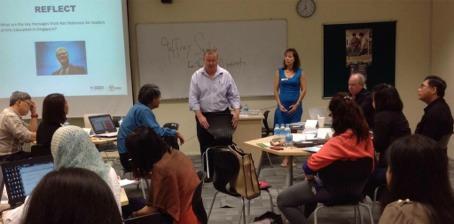
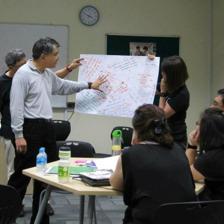
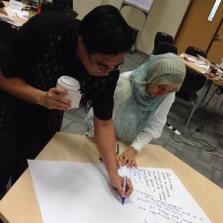
Can you imagine piling bags of clay onto a 3D structure assembled with only bamboo sticks and masking tapes? And imagine this seemingly light-weight bamboo structure could actually support two bags of clay, each weighing 10kg!
This was a discovery that eighteen experienced art teachers made during their 3D art forms module with local sculptor, Ahmad Abu Bakar. The task required teachers to construct a sturdy 3D structure that can withstand the weight of bags of clay. Through playful inquiry with materials, not only did the teachers successfully accomplished their task, they have also gained a deeper understanding of modular structures and sculptural forms, and a heightened awareness that artistic investigation and problem-solving can be fun!
These teachers were participants of the inaugural Experienced Teacher Programme, which aims to provide a time and space for professional renewal, and transformation in teaching beliefs and practices. During the ten-day programme, teachers revisited their artistic practices, explored experimental drawing approaches, and ventured into multiple exposure photography. With the intent of designing student-focused art lessons, the school art curriculum and assessment were re-examined through the lens of Understanding by Design. This experiential programme also took learning into the museums as teachers developed skills in facilitating art discussions in alternative, authentic learning spaces.
The programme has given experienced art teachers the chance to re-examine and re-define their professional knowledge and skills by re-connecting their impetus to create and make art with art teaching. We have invited a few teachers to share their learning journey with us.

Having attended the various modules and hearing the various sharing by other experienced art teachers, I am more confident that the approach towards having student-centered art lessons is the way to go. The sharing by other teachers have reinforced what I believe, and at the same time, I know that I am not alone when I face certain challenges in school. I continue to believe that when we look at the why, what, when and how we plan our art lessons, we definitely need to go back to the target audience. Our target audiences are our students — they come to us with different backgrounds and different personalities, which make our job more challenging.
Ms Koh Cheng Tee, Orchid Park Secondary School
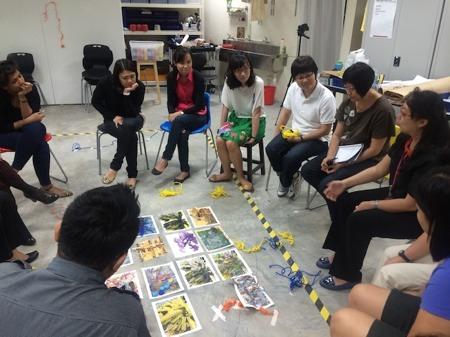
I would like to continually improve my questioning techniques, in order to be sharp and succinct in the choice of terms and questions, so that students would be able to probe further in their learning processes and become more self-directed learners. One way to do it is to pre-empt some questions and prepare them in advance, that could also complement or add to the list of essential/guiding questions in UbD.
Ms Teh Ting Ting, CHIJ Secondary School (Toa Payoh)
1. I have taken away not just new knowledge, but also a new pair of lenses that provides better clarity in the way I plan art curriculum in the future.
2. I have taken away new tools that will enable me to enhance students’ learning. Tools such as Praise-Question-Polish, Ladder of Feedback, Understanding by Design framework, Elegant Problems, 3-2-1 bridge etc.
3. I have made new friends who have contributed to this healthy communal way of learning from each other, tapping on each other’s knowledge and experiences.
Ms Lin Kaili, Northbrooks Secondary School
The course allows me to see beyond the (upper secondary) syllabus, and how one can incorporate lessons with art gallery/museum visits, and use other types of art form (e.g. contemporary art, folk art) to facilitate creativity. Although the various activities conducted appear to be disparate, the constant reflection and feedback sessions allow one to draw links between them and see the entire course as a whole. This underscores the importance of viewing the design of art lessons as a whole, with the end in mind.



MR ELIEL LIM PSD INTERN AT STAR
From 1st to 25th July, STAR had the honour of hosting three Outstanding-Educatorsin-Residence (OEIR) as they visited schools and conducted lesson demonstrations, workshops and lectures for teachers, as well as students. With years of experience as art educators and practitioners, Professor Lois Hetland, Professor Terry Barrett and Professor Olivia Gude shared their rich knowledge and insights on student-centred pedagogy and communicated their vision of art education; Professor Hetland with clarity and purpose, Professor Barrett with a quiet, firm conviction, and Professor Gude with bubbly passion.
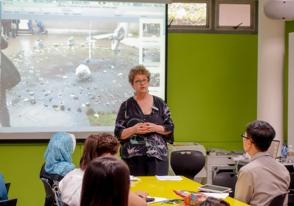
At her workshop and lesson demonstrations, Professor Hetland shared valuable insights on how thinking routines can be used purposefully to develop habitual thinking and facilitate deeper understanding in the arts. Professor Hetland also stressed the importance of creating a learning environment where students make their thinking visible by sharing ideas and perspectives. In her lecture on Reliable Assessment in the Visual Arts, Professor Hetland urged participants to reconsider the real products of an arts education and
examine the qualities of a reliable arts assessment. She also discussed with teachers how the Studio Thinking Framework could be used to develop teaching, guide curriculum planning and assess artistic learning.
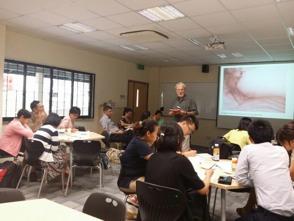
Professor Barrett conducted writing workshops, lesson demonstrations and gave lectures where he guided teachers and students to engage insightfully with works of art. He facilitated the discussions by getting teachers and students to link visual observations with their interpretations, and highlighting new insights from different viewpoints. By valuing the individual’s response to questions “What do you see?”, “What is it about?” and “How do you know?”, Professor Barrett engaged teachers in ways to establish an inclusive classroom culture where everyone observes, describes, interprets, judges positively, listens, and respects different viewpoints. After an art writing workshop for STAR champions, Ms Chuang Bee Eng from Tampines Primary School said, “I can actually use the strategies I learnt here for my classroom.” She noted how the writing prompts could open students to creative personal responses, which would be useful
not just for meaningful engagement with artworks but also for interdisciplinary writing tasks.
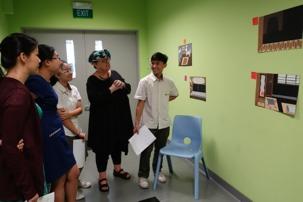
With her background in collaborative murals and mosaics, Professor Gude focused on creating personally meaningful art through engaging with memories and experiences in her workshops. Capitalising on her wealth of experience in working with inter-generational groups, Professor Gude skilfully facilitated workshops where teachers learnt along-side students. At the Psychogeography workshop, through designing public art for their schools, teachers and students examined how places shape people. For the Space and Place workshops, teachers and students explored the concept of space and created coloured paper collages of significant remembered places. In the post-workshop debriefing session after participants were given a chance to respond to one another’s artworks, Ms Gan Ai Lee from Endeavour Primary School expressed that she was pleasantly surprised by a student’s response to her artwork. “I did not expect her to be able to read in depth what my piece was about, but she quite accurately described the emotions of family and home that I was putting into my artwork.”
A common theme throughout the sessions was how art lessons could be made more engaging and relevant for students. The professors advocated for teachers to actively and intentionally facilitate collaborative learning while encouraging students’ personal engagement. They also encouraged teachers to eliminate the artificial difference between art in the ‘real world’ and ‘art’ in the classroom, making art lessons contextsensitive and personally significant for the students. During their short stint at STAR, the OEIRs have positively impacted the teachers and students, inspiring many with their passion and commitment towards the arts education, and their generosity in sharing the expertise.
Professor Hetland is a Professor of Art Education at Massachusetts College of Art and Design, and Senior Research Affiliate with Project Zero at Harvard Graduate School of Education. She is the co-author of Studio Thinking: The Real Benefits of Studio Art Education. Professor Hetland is also the co-principal investigator of the collaborative research project — The Qualities of Quality: Excellence in Arts Education and How to Achieve It. Funded by the Wallace Foundation, the project aims to clarify what constitutes high-quality teaching and learning in arts education across all art forms.
Professor Hetland’s research work in cognitive and developmental psychology focuses on issues of learning, teaching, and disciplinary understanding, with a focus in the arts.
Professor Terry Barrett is an art educator who specializes in teaching responsiveness to artworks, is Professor Emeritus at The Ohio State University where he received a distinguished teaching award for courses in criticism and aesthetics within education. A leader in the field of art criticism, aesthetics and contemporary art in education, Professor Barrett has written numerous articles, book chapters, and books, including Interpreting Art: Reflecting, Wondering, and Responding (2003) and Making Art: Form and Meaning (2010). He is former senior editor of the research journal Studies in Art Education, and is a Distinguished Fellow of the National Art Education Association.
A Professor at the University of Illinois at Chicago, Professor Olivia Gude was awarded the National Art Education Association’s “art education article of the year” Manuel Barkan Award as well as the Illinois Art Education Association’s Higher Education Art Educator of the Year. She was also awarded the 2009 NAEA Viktor Lowenfeld Award for significant contributions to the field of art education. Professor Gude has created more than 50 mural and mosaic projects, often working in collaboration with community members. She has received many grants, commissions, and awards, including two National Endowment for the Arts grants for public artworks, an Arts Midwest Regional Fellowship in Painting, and a State of Illinois Fellowship for Outstanding Achievement in the Visual Arts. She is a Senior Artist of the Chicago Public Art Group and the editor of CPAG’s on-line Community Public Art Guide: Making Murals, Mosaics, Sculptures, and Spaces. www.cpag.net
Why should teachers engage in research about education? In what ways does teacher research contribute to our collective understanding about our students’ educational experience? How does teacher research inform our teaching and develop us as reflective practitioners?
‘Research’ refers to the process of investigating something systematically, in order to generate knowledge. According to a UNESCO definition, ‘research‘ is "any creative systematic activity undertaken in order to increase the stock of knowledge, including knowledge of man, culture and society, and the use of this knowledge to devise new applications" (OECD Glossary of Statistical Terms, 2008). ‘Research’ as a process is used differently by different people belonging to different fields. In law, legal research might refer to the process of identifying and retrieving information to support legal decisions; bio-medical research might refer to the discovery of a disease or medical condition, to the development of new diagnostics and treatment protocols, or new drugs that sustain or better human health. To an artist, research methods might invariably be inter-disciplinary, crossing disciplines depending on the questions asked, the artist’s lived experiences, and the means available to conduct the research.
In an educational setting, students might take ‘research’ to mean scouring the internet for general, authoritatve secondary sources of information for a particular project; while teachers might take ‘research’ to mean an evaluation of particular aspects of education. Research promises to be a quest for meaning and ways of doing better. In some contexts, ‘educational enquiry’ is a better phrase to sum up the purpose of educational research, placing it within familiar genealogy of phrases

like ‘reflective practitioner’, ‘asking questions’, ‘exploration and explanation’, ‘assessment and evaluation’, ‘push and test things’ and ‘interruption and pattern looking’.
Ms Felicia Low, STAR’s Arts Pedagogical Research Funds (APRF) Research Consultant, shares her views on teacher research.
Why should teachers do educational research?
‘Research’ is not a word that is of immediate priority to a teacher. More commonly remembered as a process or rite of passage towards higher academic qualifications, the act of researching is often put aside once the ‘student’ moves into a ‘teacher’ role and takes on the daily responsibilities of teaching.
However, in the midst of the daily teaching responsibilities, research is an ever present process which subconsciously takes place. You have a student who is consistently unresponsive in class. Instinctively you ask your other colleagues how this student has been in other classes, you check out her past records. You take note of this student’s reactions to her friends; you begin to change your approach and see how she reacts to your change of approach. You take note of any changes; you try to figure out what approach would facilitate an improvement in response, attitude and focus. This is research. It may not look like the usual sophisticated published papers that write about how to improve student attitude and behaviour. It does however share similar characteristics of gathering empirical data, analyzing the data to come up with findings that might influence the situation at hand.
Let’s take another example. You have been tasked to create a set of lessons on proportion to be taught to two classes of Secondary 1 Express students for the following term. You have taught both classes for a term and have become familiar with the manners and ability of the students in both classes. In planning for these lessons, you would think back and retrieve information about what would excite and interest both classes respectively. You may look up resources on classical methods of proportion together with contemporary approaches to proportion through photography, for example. You piece together lesson plans that you decide would be suitable for each class. One class could be more inclined to ‘theory’, and so you begin with the theory of proportion. The other class may prefer a more hands-on approach through
photography, leading to examples of how other artists have approached proportion. Based on the reaction and progress of both classes, you decide to end the series with a lesson that plays around with the ‘rules’ of proportion creating a range of ridiculous looking drawings of un-proportionate people. The entire process above reflects much thought and consideration in making a topic relevant to the learning needs of two different groups of students. Past experience is drawn upon, new resources and ideas are collected and created, new approaches to teaching are tried and tested to produce the final pieces of art peculiar to each student regardless of which class he/she came from. This process of thought and consideration carries rich information and methods of deliberation. It is an effort that teachers often do not value for themselves. It is however an effort well worth documenting and preserving.
Why should teachers do educational research? To do their 5, 10, 15 years of teaching justice by taking their experience seriously and by giving themselves time to document, analyze and share their tried and tested approaches to teaching. This isn’t about writing a brilliant essay on the ‘pedagogy’ or ‘philosophy’ of teaching (such big enormous words!). This is about writing what you already do so that the ‘pedagogical’ approach will emerge from your practice, transforming your responsibilities from the daily grind to documents of possibilities that attest to the daily process of experimentation, innovation and discovery.
How should teachers go about starting a research project?
Teachers can start a research project by focusing on either their areas of expertise or by working on an area they want to know more about. Either way, teachers must be intrinsically motivated to work on the themes they choose – be it with regards to subject content or student management. The research project could be carried out in a manner that fits the school curriculum, where weekly lessons constitute fieldwork so that no extra time is needed to organize a new field to suit the research conditions (action research does this).
Start small – think about observing two classes as opposed to 10 classes. Select a method that you are comfortable with, be it qualitative or quantitative research. Design a research project to be manageable for yourself.
Focus the research project on answering a clear question. Don’t document everything and then say ‘hey the teaching works!’. Most, if not all teaching work at some level –the more challenging and interesting point is to figure out exactly what worked, how it worked and why it worked. This shifts the focus from the documentation of what was done in class to a more thorough analysis of what the teacher did, what the social conditions of the school and students were, and why the students responded in the way they did (as opposed to just documenting their responses).
Any other advice for novice teacher-researchers?
For a start, it is very important that the research project is manageable in its scope. It might also be useful to think about the research product as something that can be passed on to new teachers. This may help you in your writing approach, which should be clear and concise. Sometimes academic jargon can really put a damper on both the researcher and reader.
It might also be helpful to think of the research project as part and parcel of your art and teaching practice. ‘Research’ need not be such a heavy and imposing word. If accepted into our daily culture of teaching and learning for what it actually is you will find that ‘research’ is really a close cousin of ‘teaching’ and ‘learning’. As long as you have been thinking of how to make your lessons work for your students, you are already very much steeped in the process of ‘research’. This way, the word ‘research’ will not be burdened with serious overtones which may make it look boring and insurmountable. Research can be fun, and should be fun. Involve your students and colleagues, discover the silly and not-so-silly things both sides do and lo and behold –what you are writing will be relevant, engaging and a seriously good read!

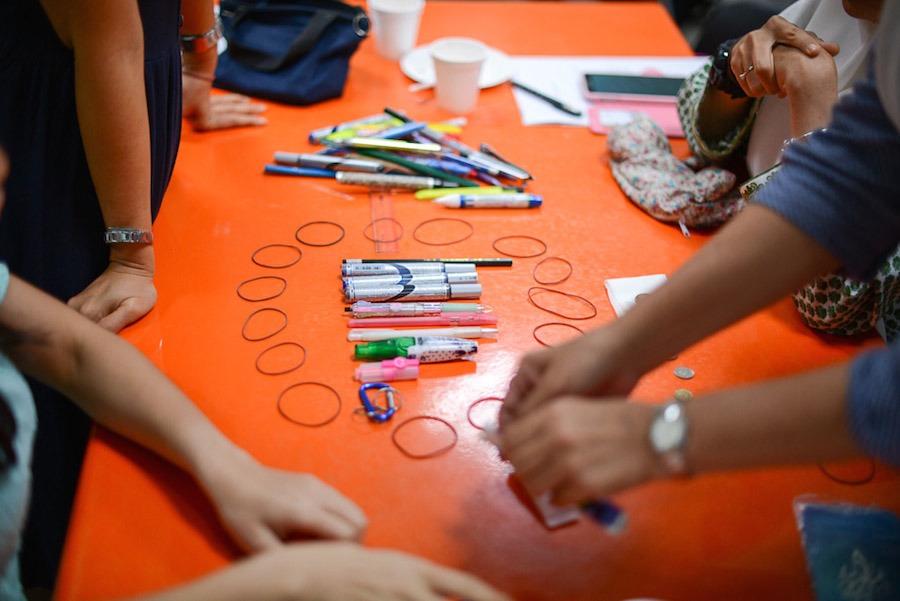
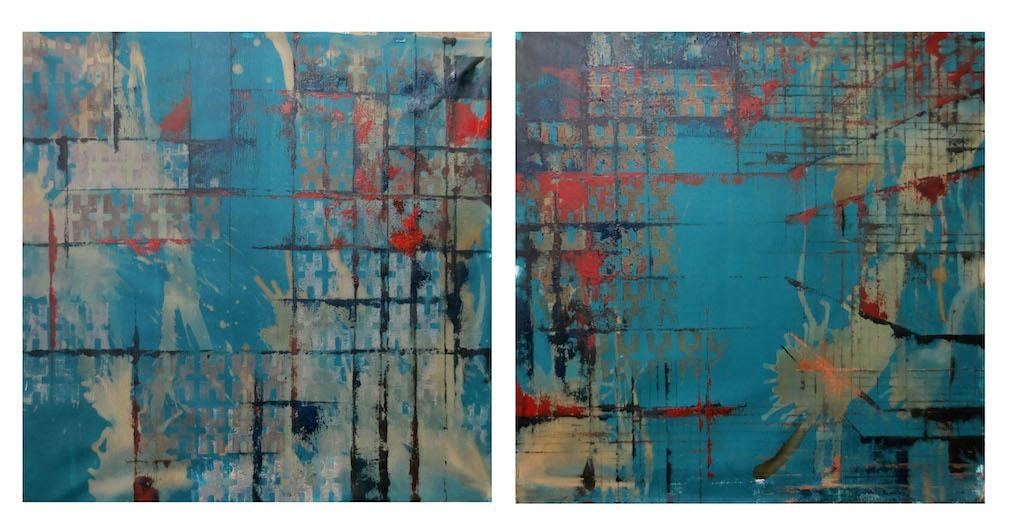
“Ahhh I can rest, finally! What have I done today? Rushed for work in the morning, rushed home from work in the evening, cooked dinner, did the laundry, tended to the children, and, now finally, bedtime.”
This was my daily routine as a working mother for the past 17 years. Because of the way I chose to live my life, I didn’t have much time for myself. All the decisions I had made were made so as to meet the needs of those I love and care for. When my children became teenagers, I started to consider the choices ahead. I didn’t want to sit and watch the world go by anymore. I made a major decision to leave everything behind, and embark on a journey to United States, to pursue a Masters in Art Education degree at Maryland Institute College of Art (MICA), to discover and rediscover myself as an artist, researcher and teacher.
Having taught the GCE ‘O’ level graduating class for so many years, I had developed a routine for my students, almost like an art making recipe. My lack of art practice all these years hindered my attempt to break out of that routine. What was this routine like? First, choose a theme. Next, make observational studies related to the theme. Look at artists’ influences and explore designs using these images. Then develop the exploratory designs into possible art pieces, and execute the artwork!
I applied the same routine to my studio practice when I first arrived at MICA. I struggled with the fear of uncertainties constantly. I didn’t know what materials to use, and what medium to work with. When I shared my fears with my studio professor, her reply struck me and left a very deep impression. It was my first lesson learnt, and it governed my entire art practice for the next 14 months. She said to me, “if you have a choice, don’t do anything safe.”

Heeding her advice, I ventured into making three-dimensional forms even though I was more comfortable as a painter. Slowly, I became more sensitive to my creative voice and pushed my limits. I was more willing to dive deeply into the unknown to satisfy my curiosity. The safe environment at MICA helped in this process. My professor’s focus was never on what I did not know, but what I knew and what else there was that I could learn to make me tell my stories in more convincing ways. I felt constantly challenged, but never ever forced, to explore my ideas and materials.
MICA’s masters programme is a low-residency programme, which meant that I was at Baltimore for only two summers of six weeks each. I returned to Singapore in August 2013 and continued my research and studio practice until June 2014, when I returned to MICA again. This experience was very authentic, as staying in Singapore meant that I had to set up a routine to balance my studio practice, my reading and writing while fulfilling the demands of a full-time teaching job.
My studio practice was far less productive when I was in Singapore, but I continued to push myself to explore the medium. I didn’t use a brush, because it was something I already knew; I explored painting with non-traditional materials such as pieces of foam boards. I also splashed, dripped, and printed on the canvas.
When I returned to MICA in June 2014, I desired to create a new body of work, even though I had no idea what forms they would take. Rather than wait for inspirations to come my way, I hung a huge piece of paper across the wall of my studio on the second day of my return, and started drawing. This was my way of confronting uncertainty. Eventually, I created six new pieces of work in five weeks for the graduation show.
My art making has transformed me both as a researcher and teacher. Having the time and space to be by myself in the studio has enabled me to be much more reflective about my art making, my teaching and my life in general.
For my research, I pushed myself to explore a different way of teaching. Vygotsky (1978), a developmental theorist and researcher, spoke of the importance of both teacher-student and student-peer interaction in the process of learning. Student-peer interaction was very lacking in my classroom because I had always felt that my students’ discussions about art was very superficial, and they could not stay on task when left on their own. I did not know how to help them elevate the discussion to a deeper level. Adopting a teacher-centred approach gave me greater control of the way my students learnt.
When I was in MICA in the first summer, I saw first-hand how everyone contributed ideas, and the professors modeled how collaborative dialogue was conducted. Thus for my research, I decided to conduct a 6-week art unit that explored ways in which my students could learn through collaboration. I incorporated opportunities for collaborative dialogue throughout the brainstorming, creation and critique phases.
The art unit and my research gave me the opportunity to challenge myself to shift from teaching through control to teaching through facilitation. Through the research, I realised that for student-peer interaction to be meaningful, we need to:
1) Build the competency level of our students
2) Set aside time for talking and thinking
3) Facilitate the discussions
4) Provide a caring environment
5) Encourage a willingness to listen to diverse opinions
My students have shown me that they are ready to take on more responsibility in creating their own learning, and I need to balance what I want to teach, with how my students desire to learn, in ways that are best suited for them.
In conclusion, I must say that making the decision to leave everything behind to embark on a journey to MICA last summer was one of the best decisions I have done for myself. The MICA experience has left me excited as an artist, fulfilled as a researcher, and rejuvenated as a teacher.


The Art Teacher Practitioner Programme (ATPP) is an upskilling programme that prepares primary school teachers with a passion for art and art teaching for the NIE Advanced Diploma in Primary Art Education. The four-month long programme culminates in an art exhibition (11 July – 4 August 2014) that celebrates the teachers’ artistic endeavours. In this essay, Miss Tan Wei Ling shares about her creative journey of exploration and discovery, as she engages in a reflective process which Lambert (1995) described as an “inner dialogue with oneself whereby a person calls forth experiences, beliefs, and perceptions”. It is through such dialogues that one examines his or her deeply seated beliefs and values, questions assumptions, seeks clarity, explores possibilities, gains new insights and eventually works towards meaningful changes to one’s teaching practice.
Preparing the artworks for the art exhibition made me realise that coming up with one piece of artwork takes a long time. Much time is spent on researching and
coming up with an idea and subsequently refining it. Doing the artwork itself is no easy feat as well. Time was spent researching on the different methods and materials. Even when an art piece is ‘completed’, a lot more time is spent on refining and sometimes even re-doing it. During the process of preparing the artwork, it dawned upon me why artworks can be so expensive. The finished art pieces we see in museums and art galleries are the result of much hard work, research, and skills, and they represent the values the artists embody and believe in.
For this exhibition, I have been challenged to explore new media and techniques. I’ve also tried to play around with styles that I did not really attempt in the past. For example, I used to be very fond of blending in colours, but for one of my works, I deliberately painted in blocks of colours, like Andy Warhol's silkscreened multiples of consumer products, in order to portray the effects of consumerism. During the process, I’ve also discovered that acrylics paints can vary in quality and even the
brushes can make a difference to the artwork. Thanks to my mentor, I’ve also discovered the different ways of using solvent transfer, as well as working with constraints. In the process, I’ve also discovered, to a small extent, the kinds of media I like to work with.
A lot of thinking was needed to curate the exhibition. How the pieces would look together, whether the ideas were related and even the position of the lighting needed to be taken into consideration. All these factors affect the audience experience of viewing the artworks.
It was definitely a challenge working within a tight timeframe and trying to cope with the daily hustle and bustle of school. However, there is also the feeling of accomplishment. It is not due to the finished art pieces, but the process — the process of discovering my own values and how I can portray them in the art pieces, my confidence also built up as I discovered the many possibilities.
As I was preparing for the exhibition, I felt art was an avenue to express something, and hopefully to touch their senses and maybe influence them. For example, in an exhibit on family ties, the viewers might be reminded of their own families and may be motivated to mend lost bonds. In an exhibit on environmentalism, the audience might be motivated to put into actions the impact the exhibition had on them. You can write an essay to influence people but not everyone likes to read, and artworks can somehow impact the other senses as well. In addition, there is something therapeutic about doing art that I cannot use words to sufficiently describe. Hopefully, I’ll discover more as I learn more about art and art teaching.
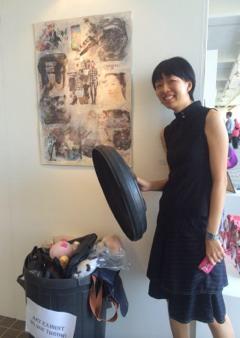
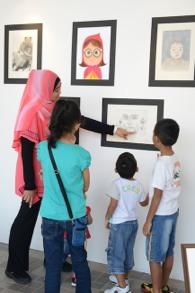

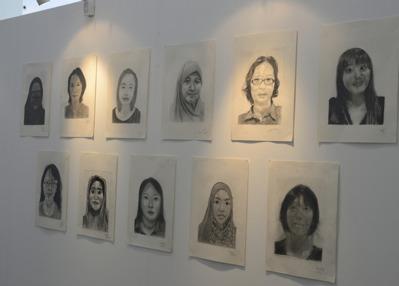
Congratulations teachers on the success of your exhibition!
MR LIM KOK BOON PROGRAMME DIRECTOR (ART), STAR
If art teaching was a journey, there are merits in knowing where exactly you want to go, and sometimes, getting completely lost in order to discover a whole new destination.
An experienced art teacher might testify that it is challenging to guide students on their personal inquiry if the path is less trodden or non-existent. A great art teacher would admit that he or she does not know everything about the art world but is willing to learn along-side the student in order to discover new paths. This might send the signal that learning is life-long, and curiosity and inquiry are necessary to make sense of life, and make life worth living.
If art teaching was a journey, like all journeys, it would have its high points and low points. There would be moments of joy when you manage to connect students to knowledge, themselves and their dreams. There would be moments of delight when your students find some breakthrough for a challenging issue; there would be moments of triumph when someone appreciates art or the things you do with art to make the world a better place. Yet there are those disconcerting moments when art education is devalued by a callous remark or forces of nature, or human intervention that derail your meticulous plans. A cloud might rain hard when the effort you put in appears undervalued by short-term measured outcomes. That same cloud might have a silver lining when your students say they have learnt far more than grades can adequately measure.
From a career perspective, art teaching might appear to be a journey with no end in mind, without the guidance of a mentor and coach. We all take sensible

risks by trying out a new strategy, take on a new assignment at school, hold a key appointment in school or apply for a posting that allows us to contribute more to our collective mission and vision. Sometimes, calculated risks are entrusted to us, taking us to a different destination.
In the book The Courage to Teach: Exploring the Inner Landscape of a Teacher’s Life, writer and educator Parker Palmer (1997) regards beliefs, identity and integrity as the foundation of teaching. They serve as your inner compass on your journey. To a large extent, teachers teach who they are. Their life experiences, learning attitudes, values, preferences and school contexts influence what, and why they teach. Their teaching styles, perspectives on education and world-views have a direct influence on how they teach. If they have an open mind, they will likely be excited about learning themselves, and want students to be self-directed learners. If they close their minds to new learning experiences, they are less likely to learn about new teaching ideas or about themselves, and belittle the importance of self-directed learning.
This teachers’ day, we invite you to think about your “wish” for your art students. Think about why you teach (what brought you into teaching), and how you might realise that wish with your students. Some of you might inadvertently use terms from the art syllabuses (hey, why not), recall things your great art teacher have said, or something that stems from your heart, brazened and polished by your life experiences. We invite you to think about your essential beliefs about teaching, and whether these are embodied by how you teach, or how your teaching is perceived. Let us also think about what it means to be an art teacher: an artist and inner child who is excited by new discoveries, materials, processes and seeing artistic works. Better still, ask your students what dreams and hope they have for themselves, their peers and for Singapore.
Some of you have contributed and shared your wishes with us, while others prefer to reflect and ponder on their wishes in private. As you think about your wishes, or read about what art teachers have written, we hope you will offer encouragement to each other in this demanding yet rewarding journey of an art teacher.
Through the process of art making and looking at art, I hope my students can become more sensitive and appreciative of life around them, thinking critically and questioning what used to be assumed. I also hope that through art, they can know themselves better and discover their own strengths and build on them.
(Ms Ong Theng Choo, Fuhua Secondary School)
Through teaching art, I want my students to be truly human in recognizing and appreciating the beauty of our world, and preserving its glory through artwork. I want to teach my students to learn to communicate from their deepest being so as to be sensitive to life and people around. I want to teach my students to be closer to an infinite beyond this world so that they can be compassionate, gentle, loving and living life to its fullest.
(Mr William Tock, Siglap Secondary School)
Art is one subject that through exploration, investigation and discovering the endless possibilities for new expression, we can make “mistakes”! It’s exciting! I wish my students will not be afraid to try and venture into the unknown. In art, there are no mistakes, but learning experiences.
(Mdm Maziyan Bte Abdullah, Sembawang Secondary School)
To have insatiable curiosities about life and its wonders; to joyfully see the beauty in things; to transform possibilities into realities; to question, think deeply and share perspectives about our place in the world.
(Miss Karen Yeh, National Junior College)
I wish for my students to discover and treasure the things that are more precious than money and material comfort through their study of art and working on coursework. Some of these things are a spirit of excellence and caring for others. These things, money cannot buy, and material comfort pales in comparison.
(Mr Heng Swee Kiang, Victoria School)
Every child is and can be an artist. Let the world be a canvas to your imagination!
(Mdm Gan Ai Lee, Endeavour Primary School)
I wish my students will discover their own potential to create art without inhibition, and be proud of the works that they create; and eventually they can find their own individual passion that is artrelated or art-inspired.
(Mrs Esther Tan-Gan Sze Ying, Nanyang Girls’ High School)
Be curious, be willing to try, and persevere in your art making!
(Ms Low Sok Hui, Hwa Chong Institution)
I believe art marks vital milestones of students' development through their accomplishments of artworks. I hope my students, as thoughtful leaders, will strive to lead and serve through the arts to impact the society in issues they believe in.
(Mr Erman Bin Abu Bakar, Swiss Cottage Secondary School)
Wishing all, a happy teachers’ day!
Through teaching of art, I hope my students can learn to appreciate their experiences (people, events, things), formulate their understanding and develop their visual and vocal expression of opinions. Their artwork will be their tool of communication to all people close and far. To me, it is important that one values their existence and learn to co-create many wonderful experiences with others who come into their paths.
(Mdm Katie Sai, Yishun Secondary School)
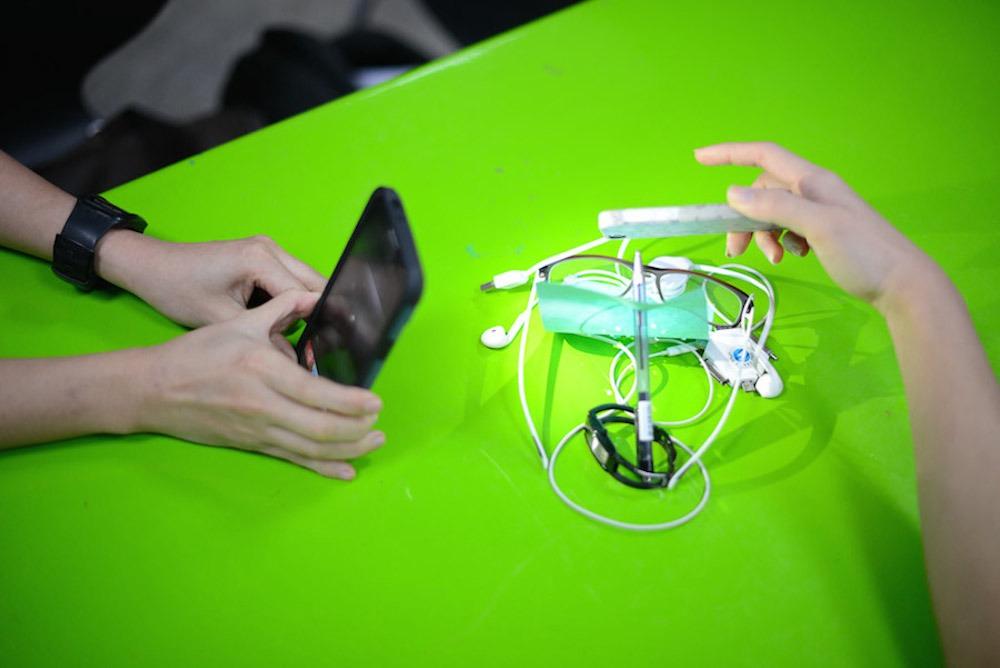
Calling all research enthusiasts!
Are you interested in researching effective student-centred arts pedagogies, in order to improve your teaching practices?
Would you like to build up your capabilities in the delivery of effective, evidence-based student-centred arts pedagogies?
We invite you to submit research proposals for the Arts Pedagogical Research Fund (APRF)!
In line with the Arts & Culture Strategic Review (ACSR) initiated by the Ministry of Information, Communications and the Arts (MICA) in 2010, the Arts Pedagogical Research Fund (APRF) is introduced to enhance teachers’ capacities to expose our students to the arts and culture through high-quality instruction.
Participating schools embark on research on arts pedagogies that extend and deepen knowledge of student-centred arts pedagogies in nurturing 21st Century Competencies set within a local context, or assessment practices in skilful Art/Music/ Drama lessons. APRF teacher-researchers are provided with research training and consultation through arrangements made by the Singapore Teachers’ Academy for the aRts (STAR) or Arts Education Branch (AEB) throughout the year in which the research is carried out.
Schools are invited to submit their research proposals by 30 October 2014. For more information, please visit STAR’s website, you may also like to attend the APRF briefing.

Briefing on Arts Pedagogical Research Fund 2015 and Artist-Mentor Scheme 2015
30 September 2014, 3.00 - 5.00pm (TBC). More details will be sent to your schools in due course. Register your interest here.
temporary closure of galleries in some NHB museums
NATIONAL MUSEUM OF SINGAPORE
Time Period Details
11 Aug 2014 - Sept 2015
29 Sept 2014 - Sept 2015
2 Nov 2014 - Sept 2015
28 Oct 2014 - end Aug 2015
End May 2015 - Aug 2015
By Sep 2015 (23 Sept TBC)
Fashion Gallery and Film Gallery closed
Photography Gallery, Food Gallery and Goh Seng Choo Gallery (William Farquhar’s Collection) closed
Singapore History Gallery closed (Audio Visual Drum included)
Opening of Temporary History Exhibition ‘Singapura: 700 Years’
All permanent galleries will be closed
All permanent galleries will re-open
Time Period Details
All West Asia Galleries (G5 and G5A) closed
23 June 2014 - End 2015
Late Nov 2014
Jan 2015 - Oct 2015
Oct 2015
Artefact affected: (P6 FBL) Miniature Qu’ran has already been re-installed outside West Asia Gallery (G5), along the new “Learning Corridor” (G3) where the current benches are
Artefact affected: The Kushana Buddha (currently in South Asia, G7) will be de-installed and re-installed in the new Gallery 2: International Buddhism
China/East Asia Gallery closed
Re-installation of objects scheduled for alternative spaces to be confirmed
Former China/East Asia Gallery renamed as Export/ Trade Gallery reopens
End 2015 West Asia Gallery reopens
Plans for renovation in SEA and South Asia galleries
2016 onwards
Contact information
National Heritage Board
Education and NHB Academy
Tel: 6332 3542
Details to be confirmed in 2015
National Museum of Singapore
Tel: 6332 3541
Email: nhb_nm_schools@nhb.gov.sg
Asian Civilisations Museum
Tel: 6332 6122
Email: nhb_educationprogrammes@nhb.gov.sg
(correct as of Aug 2014)
Email: nhb_tpm_edu@nhb.gov.sg
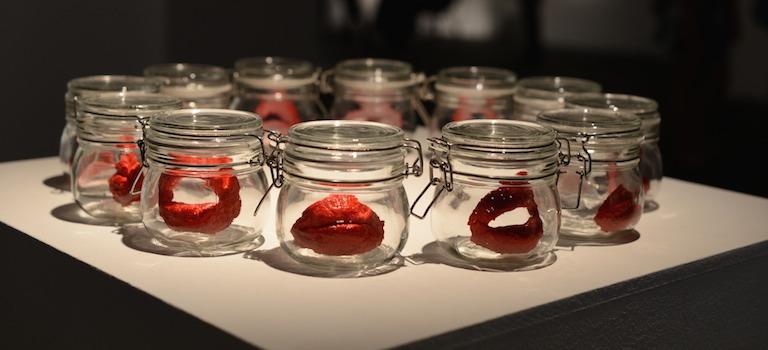
a | edge1 is an annual art exhibition that encourages art teachers to sustain and continue to hone their art practices, and enhance the professional excellence of the collective fraternity of art educators. Since 2011, the exhibition theme used graphical symbols and punctuations to convey an ongoing, playful conversation within the fraternity. In 2011, a graphical forward slash ‘/’ was used to provoke teachers to reflect about keeping a balance between their own art practices and teaching practices, and about questioning their ‘aesthetic’ edge. In 2012, we used ‘:’ to suggest dialogue, collaboration, conversations of dilemmas or ‘discursive detours’. In 2013, the hyphen was used to suggest hybridizing ideas together to show combination, unification or evolution in an artwork.
To celebrate Singapore’s Jubilee anniversary, next year’s exhibition will adopt the ellipsis ( . . . ) as the trigger and guide for the exhibition. Traditionally used as an indication for a leading statement, an unfinished thought or a slight pause, ellipsis are also used as an omission of a specific noun in certain styles of writing. An ellipsis, as a series of three dots could also represent our thoughts and reflection on our individual or collective past, present and future. We welcome you to explore, discover and create an artwork that responds to the theme.
1 an acronym for ‘Art Educators’ Developmental & Generative Explorations’
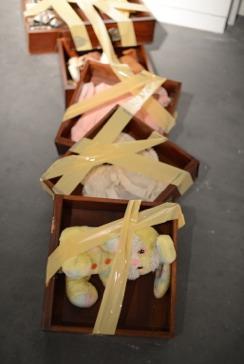
Photos feature exhibits from a-edge (2014) http://staraedge.wordpress.com

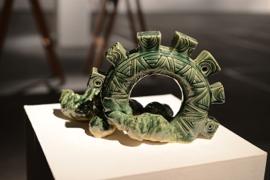
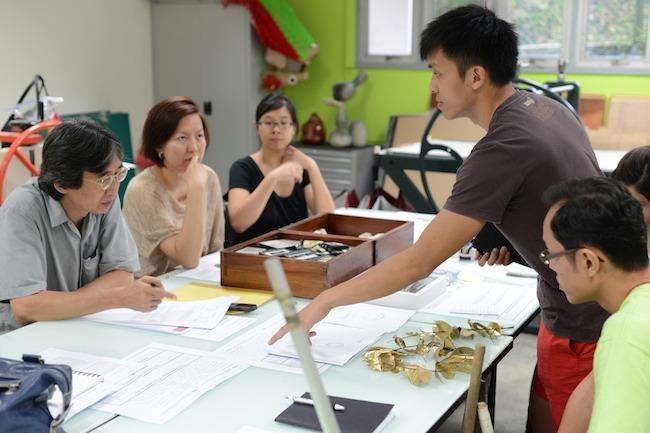

In conjunction with a edge, STAR will be organising an art camp in November 2014 to offer teachers with the time and space to conceptualise and work on an artwork for the exhibition. Local contemporary artists with various areas of expertise will be invited to offer tutorial sessions throughout the camp. All selected participants are required to:
• work with the exhibition theme
• attend scheduled tutorial sessions with artists
• document their explorations and reflections in a journal (provided)
• prepare for a critique session of artworks on the last day of the camp
Participants will be encouraged to submit proposals for the exhibition upon completion of their artworks.
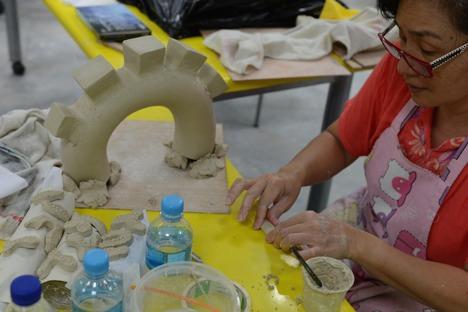
Do look out for further notification on the art camp and procedures for proposal submissions in September. The exhibition will take place in March 2015 at SOTA Art Gallery, and we look forward to your support!
Name/Designation
Mr Lim Kok Boon Programme Director (Art)
Ms Tang Hui Jing Programme Manager (Art)
Mdm Ira Wati Sukaimi
Programme Manager (Art)
Mr Lee Pheng Guan
Programme Manager (Art)
Lim_Kok_Boon@moe.gov.sg
6664 1502
Tang_Hui_Jing@moe.gov.sg
6664 1550
Ira_Wati_Sukaimi@moe.gov.sg
6664 1546
Lee_Pheng_Guan@moe.gov.sg
6664 1545
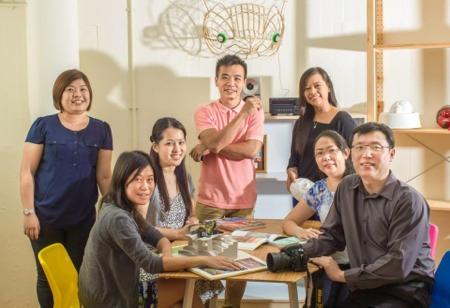

Mdm Victoria Loy
Master Teacher (Art)
Ms Grace Kwa
Programme Manager (Art)
Mdm Chun Wee San
Programme Manager (Art)
Ms Tan Bee Ngoh
Programme Executive
Victoria_Loy@moe.gov.sg
6664 1551
Grace_Kwa@moe.gov.sg
6664 1547
Chun_Wee_San@moe.gov.sg
6664 1552
Tan_Bee_Ngoh@moe.gov.sg
6664 1549


http://www.star.moe.edu.sg